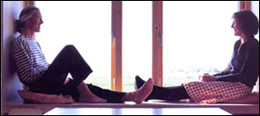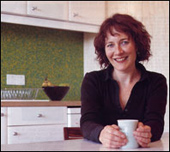 Green might just be the new black when it comes to country living. Ben Osborn met novelist Jill Dawson and family at their Cambridgeshire home to find out why.
Green might just be the new black when it comes to country living. Ben Osborn met novelist Jill Dawson and family at their Cambridgeshire home to find out why.
Just four miles outside Ely, but set deep in the never-ending horizons of the Fenland landscape, it might seem something of a cliché to find a writer tucked away in her country abode in the tiny village of Prickwillow. But Jill Dawson, whose novel Fred and Edie was nominated for the Whitbread Novel of the Year in 2000 and shortlisted for the Orange Prize, is anything but the ago-saga type. Equally non-conformist is the house she lives in, designed by her architect husband Meredith Bowles and shared with her two boys Lewis (14) and Felix (3).
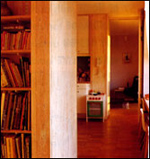 Having grown up in Yorkshire, Jill spent most of the last two decades as a happily converted Londoner. Nevertheless, the time came when she felt it was right to move on. “1 loved living there, but when I became pregnant with Felix I just felt I didn’t want to bring up another child in the city,” explains Jill. Buying their small plot of land back in 2000, it’s clear that a typically English rural idyll was not quite what they had in mind. “The idea of a house that’s just stuck on a field in the middle of nowhere drew me – it’s the antithesis of that chocolate-box, very British village look,” says Jill. “1 grew up in a pretty countryside setting, but I didn’t want to replicate that – I find this a more interesting and unusual sort of environment.”
Having grown up in Yorkshire, Jill spent most of the last two decades as a happily converted Londoner. Nevertheless, the time came when she felt it was right to move on. “1 loved living there, but when I became pregnant with Felix I just felt I didn’t want to bring up another child in the city,” explains Jill. Buying their small plot of land back in 2000, it’s clear that a typically English rural idyll was not quite what they had in mind. “The idea of a house that’s just stuck on a field in the middle of nowhere drew me – it’s the antithesis of that chocolate-box, very British village look,” says Jill. “1 grew up in a pretty countryside setting, but I didn’t want to replicate that – I find this a more interesting and unusual sort of environment.”
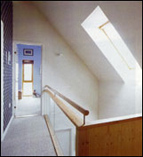 Coming in to Prickwillow, The Black House is immediately recognisable from the dark timber framework that gives it its name. It’s typical of many barn-style buildings you can find throughout the Fens, but also one of the many “green” features of this specially designed “eco-house” – proving that accommodation can be simultaneously stylish, environmentally friendly and comfortable to live in. Bathed in the natural light that floods into their kitchen and living room, Meredith explains his motivation behind the environmental aspects of the design. “Two thirds of Britain’s energy use goes into heating houses, which is pretty staggering when you think about it,” he says. “So there are two main principles at work here. The first is to save energy – there’s really effective insulation in place and also a very efficient air-heating system which can reclaim about 85% of the energy lost through exhaust air. “The second principle was to use natural or recycled materials wherever possible. I took inspiration from old buildings which were nearly always constructed from readily available local materials – and therefore have less negative impact on their environment.” But unlike some of the perfectly formed houses designed by the architects who live in them, The Black House is very much a family’s working home as well as a labour of love.
Coming in to Prickwillow, The Black House is immediately recognisable from the dark timber framework that gives it its name. It’s typical of many barn-style buildings you can find throughout the Fens, but also one of the many “green” features of this specially designed “eco-house” – proving that accommodation can be simultaneously stylish, environmentally friendly and comfortable to live in. Bathed in the natural light that floods into their kitchen and living room, Meredith explains his motivation behind the environmental aspects of the design. “Two thirds of Britain’s energy use goes into heating houses, which is pretty staggering when you think about it,” he says. “So there are two main principles at work here. The first is to save energy – there’s really effective insulation in place and also a very efficient air-heating system which can reclaim about 85% of the energy lost through exhaust air. “The second principle was to use natural or recycled materials wherever possible. I took inspiration from old buildings which were nearly always constructed from readily available local materials – and therefore have less negative impact on their environment.” But unlike some of the perfectly formed houses designed by the architects who live in them, The Black House is very much a family’s working home as well as a labour of love.
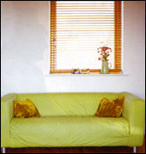 Sitting on the spacious window seats which look out towards Ely Cathedral in the distance, Jill points out some ofthe features use a space and designing something that enhances that usage.”
Sitting on the spacious window seats which look out towards Ely Cathedral in the distance, Jill points out some ofthe features use a space and designing something that enhances that usage.”
“THERE’S A STRONG RELATIONSHIP BETWEEN BUILDING SOMETHING THAT’S SUSTAINABLE AND CREATING A COMFORTABLE LIVING ENVIRONMENT”
Built on stilts to avoid the need for extensive foundations, this three-storey building is tall rather than expansive – but there’s still plenty of room for both children and the two home-working adults. With Meredith’s office for Mole Architects on the first floor, Jill works from a small but well-lit room one floor above. It is, as you might imagine, an important space for someone occupied in an often solitary profession. “This was the first time I’ve ever really had a study, so
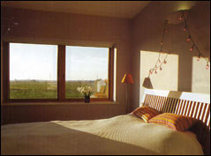 Meredith had a tall order to get it right,” she says. “In London I used to live on the fifth floor of a building for a long time – I quite liked being high up, secluded from the world but still able to look out on it. Now I’ve got an attic study it’s perfect. With windows in three directions, I can see out but people can’t look in on me!” Currently promoting her fourth novel Wild Boy, Jill is also involved with plans to turn the book into a feature film. Meredith, meanwhile, is busy working on further eco- projects – a result of the widespread media interest he’s had in The Black House. For the two of them, there’s a sense that they’ve created something both permanent and positive for the future. “To me there’s a strong relationship between building something that’s sustainable and a creating comfortable living environment,” says Meredith, “I think being aware of your environment increases your enjoyment of life.” But while he may be looking forward to the challenge of his next eco- house, Jill is happy right where she is. “When you’ve had a home that was effectively built for you, you’re very lucky,” she says. “That’s why I don’t think I’ll ever want to move.”
Meredith had a tall order to get it right,” she says. “In London I used to live on the fifth floor of a building for a long time – I quite liked being high up, secluded from the world but still able to look out on it. Now I’ve got an attic study it’s perfect. With windows in three directions, I can see out but people can’t look in on me!” Currently promoting her fourth novel Wild Boy, Jill is also involved with plans to turn the book into a feature film. Meredith, meanwhile, is busy working on further eco- projects – a result of the widespread media interest he’s had in The Black House. For the two of them, there’s a sense that they’ve created something both permanent and positive for the future. “To me there’s a strong relationship between building something that’s sustainable and a creating comfortable living environment,” says Meredith, “I think being aware of your environment increases your enjoyment of life.” But while he may be looking forward to the challenge of his next eco- house, Jill is happy right where she is. “When you’ve had a home that was effectively built for you, you’re very lucky,” she says. “That’s why I don’t think I’ll ever want to move.”
